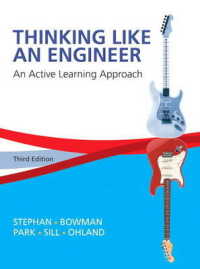Full Description
Rhythm is the fundamental pulse that animates poetry, music, and dance across all cultures. And yet the recent explosion of scholarly interest across disciplines in the aural dimensions of aesthetic experience--particularly in sociology, cultural and media theory, and literary studies--has yet to explore this fundamental category. This book furthers the discussion of rhythm beyond the discrete conceptual domains and technical vocabularies of musicology and prosody. With original essays by philosophers, psychologists, musicians, literary theorists, and ethno-musicologists, The Philosophy of Rhythm opens up wider-and plural-perspectives, examining formal affinities between the historically interconnected fields of music, dance, and poetry, while addressing key concepts such as embodiment, movement, pulse, and performance. Volume editors Peter Cheyne, Andy Hamilton, and Max Paddison bring together a range of key questions: What is the distinction between rhythm and pulse? What is the relationship between everyday embodied experience, and the specific experience of music, dance, and poetry? Can aesthetics offer an understanding of rhythm that helps inform our responses to visual and other arts, as well as music, dance, and poetry? And, what is the relation between psychological conceptions of entrainment, and the humane concept of rhythm and meter? Overall, The Philosophy of Rhythm appeals across disciplinary boundaries, providing a unique overview of a neglected aspect of aesthetic experience.
Contents
List of Illustrations
List of Abbreviations
Notes on Contributors
Introduction
Part I: Movement and Stasis
1. Dialogue on Rhythm: Entrainment and the Dynamic Thesis
2. Rhythm and Movement
3. The Ontology of Rhythm
4. 'Feeling the Beat': Multimodal Perception and the Experience of Musical Movement
5. Dance Rhythm
Part II. Emotion and Expression
6. The Life of Rhythm: Dewey, Relational Perception, and the 'Cumulative Effect'
7. Rhythm, Preceding its Abstraction
8. Mozart's 'Dissonance' and the Dialectic of Language and Thought in Classical Theories of Rhythm
9. Rhythm and Popular Music
10. Rhythms, Resemblance, and Musical Expressiveness
Part III: Entrainment and the Social Dimension
11. Metric Entrainment and the Problem(s) of Perception
12. Entrainment and the Social Origins of Musical Rhythm
13. How Many Kinds of Rhythm Are There?
14. Temporal Processing and the Experience of Rhythm: A Neuro-psychological Approach
Part IV. Time and Experience: Subjective and Objective Rhythm
15. Complexity and Passage: Experimenting with Poetic Rhythm
16. Encoded and Embodied Rhythm: An Unprioritized Ontology
17. Time, Duration, Rhythm: The Aesthetics of Temporality in Bachelard and Deliège
18. Husserl's Model of Time-Consciousness, and the Phenomenology of Rhythm
19. Pictorial Experience and the Perception of Rhythm
20. Soundless Rhythm
Part V. Reading Rhythm
21. Hearing it Right: Rhythm and Reading
22. The Not-so-silent Reading: What Does it Mean to Say that we Appreciate Rhythm in Literature?
23. Leaving it Out: Rhythm and Short Form in the Modernist Poetic Tradition
24. Rhythm, Meter, and the Poetics of Abstraction







